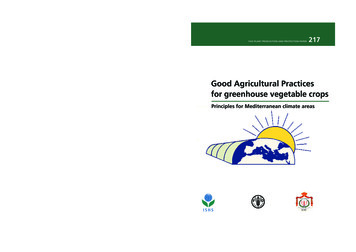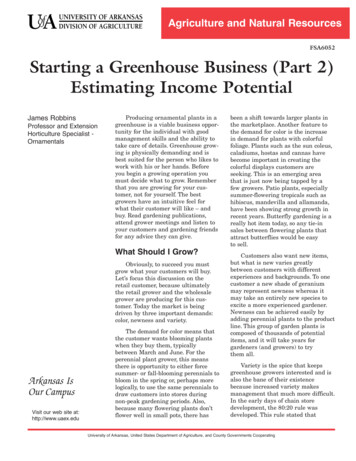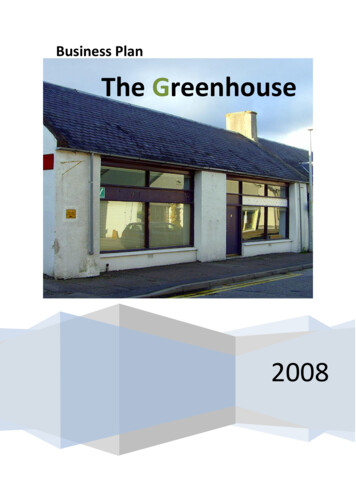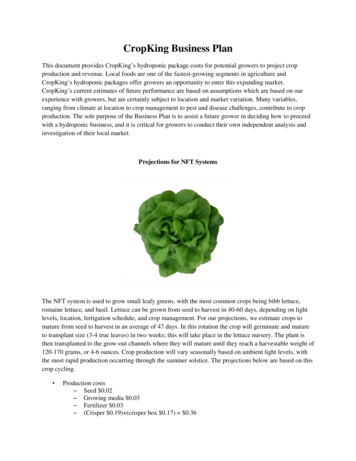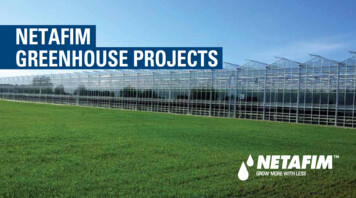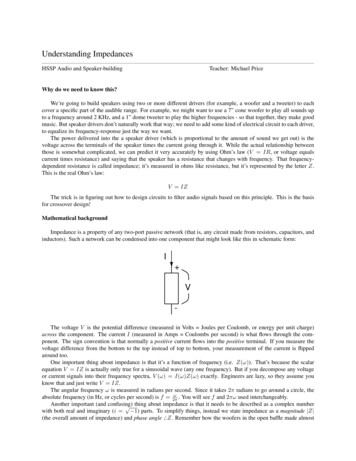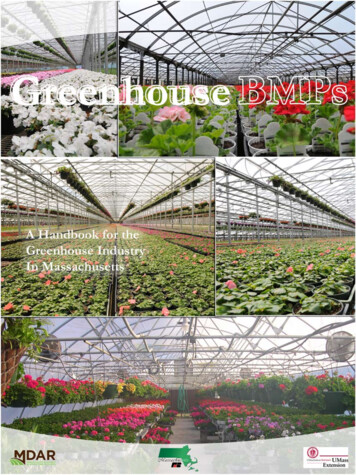
Transcription
MASSACHUSETTS GREENHOUSEINDUSTRY BEST MANAGEMENTPRACTICES GUIDECover page photos: Tina Smith, UMass Extension
TABLE OF CONTENTSACKNOWLEDGEMENTS . iiiOVERVIEW OF BEST MANAGEMENT PRACTICES. 1TYPES OF GREENHOUSES. 1SITE PLANNING: STORMWATER AND WASTEWATER. 3WATER: SUPPLY AND SOURCES . 7PROTECTING GROUNDWATER FROM CONTAMINATION. 12WATER ANALYSIS . 14WATER QUALITY FOR CROP PRODUCTION. 17IRRIGATION SYSTEMS. 30EFFECTS OF GROWING MEDIA ON WATER AND NUTRIENT MANAGEMENT . 34NUTRIENT MANAGMENT. 40SOIL TESTING . 51FERTILIZER STORAGE AND HANDLING. 60MASSACHUSETTS PROHIBITED PLANTS. 65WORKER PROTECTION STANDARD. 67PESTICIDE STORAGE, HANDLING AND DISPOSAL. 69PESTICIDES AND GROUNDWATER PROTECTION . 77PESTICIDE LICENSING. 81INTEGRATED PEST MANAGEMENT . 84PEST MANAGEMENT: PROPER USE OF PESTICIDES . 91DISEASE MANAGEMENT . 95PLANT PROBLEM DIAGNOSTIC SERVICE . 107WEED MANAGEMENT . 109ANIMAL DAMAGE MANAGEMENT . 116
ORGANIC WASTE MANAGEMENT. 118INORGANIC WASTE MANAGEMENT . 126ENERGY . 129GOOD AGRICULTURAL PRACTICES . 135References . 136Resources . 139Appendix A, Massachusetts Prohibited Plant List. . 144
ACKNOWLEDGEMENTSCompiled by Tina Smith and Paul Lopes, University of Massachusetts ExtensionSection AuthorsDouglas Cox, University of Massachusetts: Nutrient Management, Water Quality for CropProduction, CompostingNatalia Clifton, University of Massachusetts: Pesticide StorageJohn W. Bartok, Jr., University of Connecticut: Stormwater and Wastewater Management,Horizontal Air Flow, Energy ConservationTaryn LaScola, Pesticide Division, Massachusetts Department of Agricultural Resources:Pesticide Licensing Frequently Asked QuestionsThe Greenhouse BMP Manual was reviewed by a Grower Advisory Board consisting of JodieGilson, J. Gilson Greenhouses Inc.; Jason Hutchins, The Flower Hutch; David Giurleo, ColonialGardens; Fred Hulme, The Scotts Company and by Brad Mitchell, Massachusetts Farm BureauFederation and Michael Botelho, Massachusetts Department of Agricultural Resources.Prepared June, 2010DisclaimersMention of trade names and products is for information purposes only and constitutes neither anendorsement of, recommendation of, nor discrimination against similar products not mentioned.Although this guide contains research-based information and the contributors have used theirbest efforts in preparing this guide, the contributors make no warranties, express or implied, withrespect to the use of this guide. Users of this guide maintain complete responsibility for theaccuracy and appropriate application of this guide for their intended purpose(s).In no event shall the contributors be held responsible or liable for any indirect, direct, incidental,or consequential damages or loss of profits or any other commercial damage whatsoeverresulting from or related to the use or misuse of this guide.The contributors emphasize the importance of consulting experienced and qualified consultants,advisors, and other business professionals to ensure the best results for producing nursery stock.
OVERVIEW OF BEST MANAGEMENT PRACTICESA set of production guidelines known as Best Management Practices (BMPs) for the purposes ofthis manual are voluntary activities undertaken to minimize negative effects on the environment.The manual is not intended for regulations. BMP considerations for greenhouse productioninclude site selection, water management and irrigation, nutrient management, composting,prohibited plants, pesticide use and storage, insect, mite, disease and weed management, animaldamage management, organic and inorganic waste management, and alternative energy andenergy conservation. BMPs are adaptable for the diversity that exists within the industry.Applying these practices will help Massachusetts greenhouses and nurseries to remain (orbecome) healthy and profitable.TYPES OF GREENHOUSESA greenhouse is a structure with a glass or plastic roof and side walls that is used for theproduction of ornamentals and food crops and may be used seasonally or year round. The closedenvironment of a greenhouse has its own unique requirements, compared with outdoorproduction. Pests and diseases, and extremes of heat and humidity, have to be controlled, andirrigation is necessary to provide water. Significant inputs of heat and light may be required,particularly with winter production of warm-weather crops.Greenhouses for commercial production can be classified as free-standing or gutter-connected.A free-standing greenhouse can have a quonset (hoop), gothic or gable roof shape. The quonsetis usually the least expensive and is available in widths up to 36'. Gothic designs have higherlight transmission and shed snow easier. Gable designs may use trusses to span a width up to 60'.A gutter-connected greenhouse is a series of trusses connected together at the gutter level.Individual bays vary in width from 12' to 25' and have a clearance of 8' to 16' to the gutter. Bayscan be put together to get any width of greenhouse desired.Greenhouses can be made any length. Standard lengths that utilize glazing materials to advantageare 96' and 144'. All greenhouses are modular with frame spacing of 4' or 5' for hoophouses and10' or 12' for gutter-connected designs.Most greenhouses are built of galvanized steel tubing and are available from manymanufacturers throughout the U.S. Steel makes a strong frame to carry snow and wind loads andstill allow about 80% of the light to enter.Most greenhouses are covered with a plastic glazing. Low-cost polyethylene film or coveringapplied as an air inflated double cover will last 4 years. Anti-drip agents and infra-red inhibitorsare added to give better service and reduced heat loss. Semi-rigid structured sheets ofpolycarbonate or acrylic are more permanent and have a life of at least 15 years. Tempered glassis used for crops requiring high light levels.The following is a short review of the advantages of the different styles of structures:Types of Greenhouses1
Free-standing Greenhouses Easier to provide separate environments as each house is controlled by its ownheating/cooling system. One house can be run warm for propagation and the next one,cooler for growing. Individual houses can be shut down for periods when not in use saving energy. Best suited for heavy snow areas as multi-span houses need heat to melt snow from thegutters. Good for non-level sites. Individual houses are easier to build and maintain.Gutter-connected Greenhouses More cost effective for areas greater than 20,000 sq ft. Reduced heating costs as surface area to floor area ratio is less. Heating costs can be asmuch as 25% less due to reduced glazed area. Less land is needed. About 30% more growing space can be placed on the same amountof land area. Heat can be centralized. Open-roof designs that eliminate fans and reduce electricity use are available.Production SystemsIn addition to the greenhouse style, there are a variety of production systems used inside thegreenhouse. Some crops are grown in containers on benches, such as many spring ornamentalcrops, while others are grown in the soil in the ground such as cut flowers or vegetable crops (ie.tomatoes, lettuce). Some crops are grown in containers or bags of growing media that are placedon the ground (tomatoes). Some greenhouses have soil or gravel floors, some have concretefloors and some have a combination. All of these differences contribute to best managementpractices that will vary according to the greenhouse and systems used for production.ReferenceBartok, J.W., Jr. 2005. Selecting and Building a Commercial fact sheets/greenhouse management/jb building gh.htmTomatoes Grown in Containers inFree Standing GreenhouseHeated Bench System for Propagationin Gutter-connected GreenhousePhoto: Paul Lopes, UMass ExtensionPhoto: Tina Smith, UMass Extension2Types of Greenhouses
CHECKLISTSITE PLANNING: STORMWATER AND WASTEWATER Be aware that agricultural activities are subject to the jurisdiction of the MassachusettsWetland Protection Act (WPA) when they occur within the resource areas (and their 100foot buffer zones) defined in the Act. Many normal farming activities are exempt fromregulations under the WPA. For information on the Massachusetts Wetland ProtectionAct, contact Massachusetts Department of Environmental /wmgforms.htm, phone [617]-292-5706). Growers planning to withdraw water from ground or surface sources in excess of anannual average of 100,000 gallons per day or 9 million gallons in any three month periodmust apply for a Water Management Act permit. Note that municipalities may also havewater withdrawl requirements. Allow time for zoning, wetlands and building permits that may be required. Permitsusually take several months to obtain due to infrequent meeting schedules and publichearing requirements. Use BMPs to handle wastewater from greenhouse roofs, driveways, parking areas, indoorgrowing areas, outdoor growing beds, flood floors and benches. Adopt integrated pest management practices and avoid pesticides which are persistent,have high leaching potentials, or move readily on the surface. Reduce pesticide use by properly timing the pesticide application and subsequentevaluation of the resulting level of pest control. Stormwater and wastewater management systems may require an engineer to designhandle maximum runoff conditions. Permits may also be required. USDA NaturalResource Conservation Service (NRCS) may be a resource. See “Resources” for contactinformation. For new construction, contact Massachusetts Department of AgriculturalResources, Division of Technical Assistance for information on current regulations onstormwater and wastewater management. Consider directing rainwater from greenhouses to a retention pond or constructed wetlandto allow most sediment to settle out before it reaches a brook or stream. For gutter-connected greenhouses, consider installing a rainwater harvesting system tostore some of the water to use for irrigation.Site Planning: Stormwater and Wastewater3
SITE PLANNING: STORMWATER AND WASTEWATERAs greenhouse operations add more growing space, support buildings and vehicle access area,stormwater and wastewater management becomes more important. Good management, includingsite planning, source controls and pollution prevention can help growers reduce environmentalimpact and keep water resources clean.SlopeSites where greenhouses are located should have a gentle slope to the south for good winter lightand protection from northerly winds and to provide drainage of rain and runoff. A fairly levelsite with a 1% to 2% slope reduces site preparation costs. Greenhouses should be placed on agravel base, 6" to 12" above grade. Swales between greenhouses are necessary to direct the waterfrom the area.Wetlands Protection Act and Water Management ActWetland and water resources are found on many Massachusetts farms. These resource areasinclude (but are not limited to) streams, ponds, bogs, marshes, swamps, floodplains, isolated landsubject to flooding, wet meadows, salt ponds, salt marshes, and fish runs. Agricultural activitiesare subject to the jurisdiction of the Massachusetts Wetland Protection Act (WPA) when theyoccur within the resource areas (and their 100-foot buffer zones) defined in the Act.Many normal farming activities are exempt from regulations under the WPA. O
A greenhouse is a structure with a glass or plastic roof and side walls that is used for the production of ornamentals and food crops and may be used seasonally or year round. The closed environment of a greenhouse has its own unique requirements, compared with outdoor production. Pests and diseases, and extremes of heat and humidity, have to be controlled, and irrigation is necessary to .
